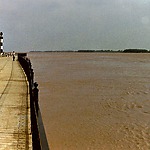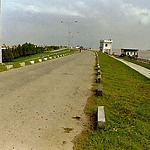The Yangtze River Basin covers one-fifth of China's land area and is home to nearly one-third of its population, more than 400 million people, millions of whom living in cities like Wuhan, Nanjing, and Shanghai. For thousands of years, the river has been used for irrigation, drinking and industrial water, and transportation. In the river's delta much as 20% of China's Gross Domestic Product is being generated.
In July 2000, I visited several areas in China, including some places along Yangtze River, with an international mission to map out possibilities for research and cooperation in the field of irrigation and drainage. We also visited a place where the dikes along the river had been breached several times over the centuries. At this place now stands an impressive statue of a wolf, which has the symbolic task of preventing future flooding.
The wolf is there for a clear purpose. Although the dikes are now much stronger than in the past, the consequences of a dike breach at this location would be enormous. Wuhan alone has more than eleven million inhabitants and an enormous value of buildings and infrastructure. While the area is very flat, a dike breach also immediately floods a huge area. Major floods occurred, among others, in 1919, 1935, 1954, 1998 and 2020.
Although, as mentioned, the dikes are stronger than in the past, the safety level is considerably lower than we have for the river dikes in the Netherlands. However, it would be very expensive to bring the dikes up to a safety level like we have in the Netherlands, while not only the discharge of the Yangtze is very high, but also because extreme conditions in China are more extreme than in our moderate climate. For comparison, the average discharge of the Rhine at Lobith, where the river enters the Netherlands, is 2,000 cubic metres per second. The average discharge of Yangtze River at Wuhan is 25,000 cubic metres per second. In the context of the Dutch Room for the River project, our river dikes have been reinforced in recent years to be able to withstand a discharge of the Rhine at Lobith of 16,000 cubic metres per second. Eight times as much as the average discharge of the Rhine, but approximately two-thirds of the average discharge of the Yangtze.
In 2012, the Three Gorges Dam was completed upstream of Wuhan. This is one of the largest dams in the world. The dam was mainly built to generate energy, but of course also has a regulating function for the discharge, which can at least reduce flooding. In June and July of 2000, this was also very necessary, because extreme amounts of rain fell in the river basin at that time. Then some places were still flooded.
We may therefore hope that the symbolic value of the wolf will not only remain symbolic, but that the continuous care for and improvement of the strength of the dikes will also be realised as good as possible.




